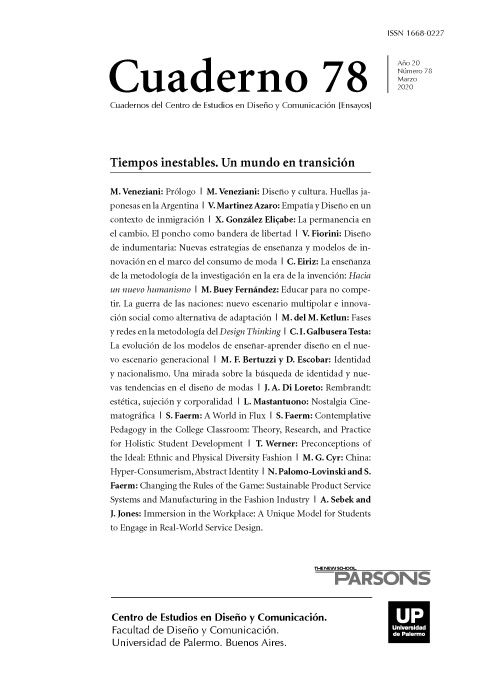La evolución de los modelos de enseñar-aprender diseño en el nuevo escenario generacional
Abstract
Teaching-learning design poses challenges in the context of the current global paradigm. The generations of Baby-Boomers (1945-60) and X (1961-79), trained in times of cold war, are the didactic organizers of the NET generations or of digital natives: Millenials (1980-1993), Z (1994- 2009) and Touch (2010-today). Quantitative and qualitative changes occur at an accelerated speed in the economic, political, social, environmental, technological and symbolic dimensions from the end of the 20th century and the beginning of the 21st. New teaching / learning modalities product of generational changes, invite critical reflection.
References
Ala-Mutka, K.; Bacigalupo, M.; Kluzer, S.; Pascu, C.; Punie, Y. y Redecker, C. (2009). Learning 2.0: The impact of Web 2.0. Innovations on education and training in Europe. Institute for Prospective Technological Studies. Joint Research Centre. European Commission. Disponible en: http://ipts.jrc.ec.europa.eu/publications/pub.cfm?id=2139.
Castells, M. (1997-98). La era de la información (3 vols.). Madrid: Alianza.
Castells, M. (2001). La galaxia Internet. España: Ed. Arete.
Coupland D. (1991). Generation X: Tales for an Accelerated Culture. Nueva York: St. Martin’s Press.
Downes, S. (2004). Educational blogging, Educause Review, 39(5). Disponible http://connect.educause.edu/Library/educause+Review/EducationalBlogging/40493
European Commission (2001). Communication: Making a European area of lifelong learning a reality. Disponible en: http://www.europa.eu.int/comm/education/life/index.htm
Ferreiro, R. (2000). Nuevos ambientes de aprendizaje, INPUT. No. 21, Barcelona. pp. 72-74.
Kahnwald, N. (2009). Social software as a tool for informal learning, Elearning Europa, Disponible en: http://www.elearningeuropa.info/files/media/media19951.pdf.
Kostyrka-Allchorne K., Cooper NR, Simpson A. (2017). Touchscreen generation: children’s current media use, parental supervision methods and attitudes towards contemporary media. Acta Pædiatrica; 106: 654-662.
Lévy, P. (1998). Becoming virtual: reality in the Digital Age. Nueva York: Plenum Trade.
McLuhan, M. (1971). Guerra y paz en la aldea global. Barcelona: Martínez Roca.
Monereo, C. (2004). La construcción virtual de la mente: implicaciones psicoeducativas, Interactive Educational Multimedia, 9. Disponible en: http://www.ub.edu/multimedia/iem/down/c9/Construction_of_the_mind_%28SPA%29.pdf
Negroponte, N. (1995). El mundo digital. Barcelona: Ediciones B.
Negroponte, N. (1996). Ser digital. México: Océano.
Prensky, M. (2001). Digital Natives, digital inmigrants, On the Horizon, 9 (5). Disponible en: http://www.marcprensky.com/writing/Prensky%20-%20Digital%20Natives,%20Digital%20Immigrants%20-%20Part1.pdf
Prensky, M. (2009). H. sapiens digital: From digital immigrants and digital natives to digital wisdom, Innovate, 5 (3). Disponible en: http://www.innovateonline.info/pdf/vol5_issue3/H._Sapiens_Digital-__From_Digital_Immigrants_and_Digital_Natives_to_Digital_Wisdom.pdf
Tapscott, D. (1998). Growing up digital: The rise of the Net generation. Nueva York: McGraw-Hill.
Trinder, K; Guiller, J; Margaryan, A.; Littlejohn, A; Nicol, D. (2008). Learning from digital natives: bridging formal and informal learning. Research project report. The Higher Education Academy. Glasgow Caledonian University. Disponible en: http://www.academy.gcal.ac.uk/ldn/LDNFinalReport.pdf.
er Encuentro BID de Enseñanza y Diseño, Madrid (2011). Disponible en: http://bid-dimad.org/encuentro/documentos/Memoria_3er-Encuentro-BID.pdf
° Encuentro BID De Centros Iberoamericanos De Enseñanza De Diseño, (2013) Central de Diseño /Matadero Madrid. Disponible en: http://bid-dimad.org/septimoencuentro/wp-content/uploads/2017/04/firmantes-encuentro.pdf
º Encuentro Bid De Centros Iberoamericanos De Enseñanza De Diseño, (2015), Central de Diseño, Matadero, Madrid Organiza: DIMAD. Disponible en: http://bid-dimad.org/sextoencuentro/innovacion-docente/
º Encuentro Bid De Centros Iberoamericanos de Enseñanza de Diseño, (2017), Central de Diseño, Matadero, Madrid Organiza: DIMAD. Disponible en: http://bid-dimad.org/septimoencuentro/es/disenar-para-un-mundo-complejo-2/
Los autores/as que publiquen en esta revista ceden los derechos de autor y de publicación a "Cuadernos del Centro de Estudios de Diseño y Comunicación", Aceptando el registro de su trabajo bajo una licencia de atribución de Creative Commons, que permite a terceros utilizar lo publicado siempre que de el crédito pertinente a los autores y a esta revista.


